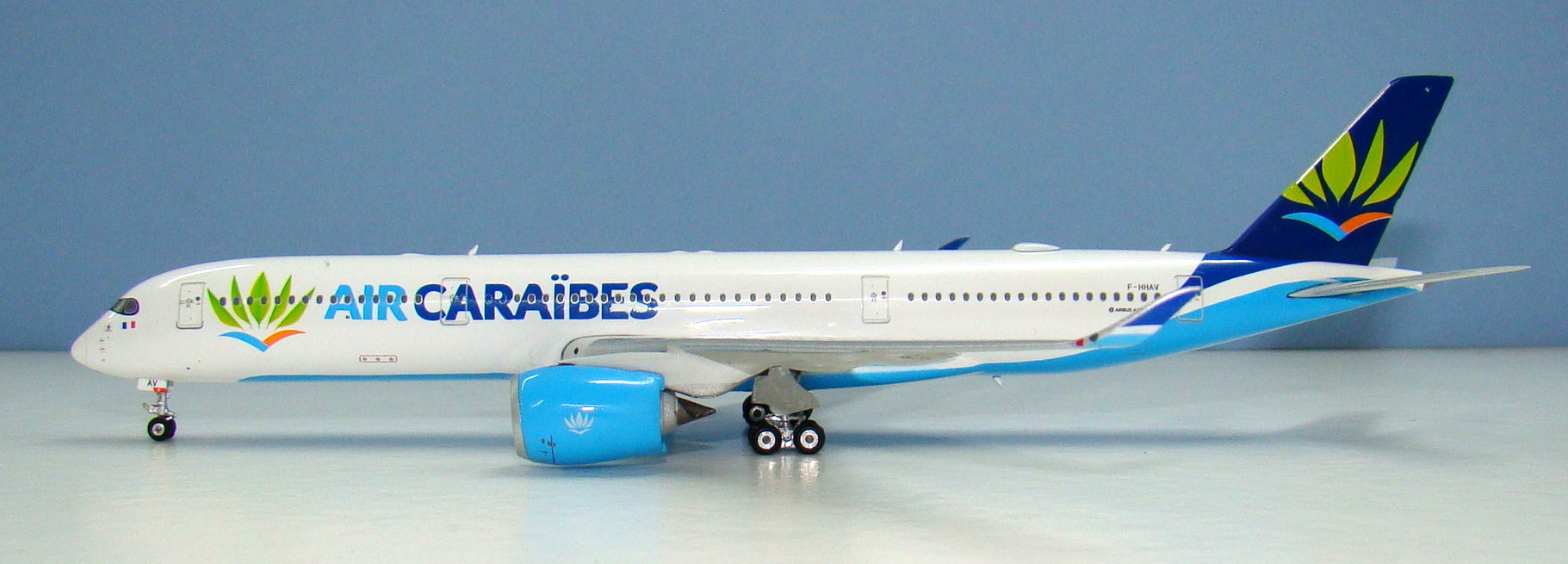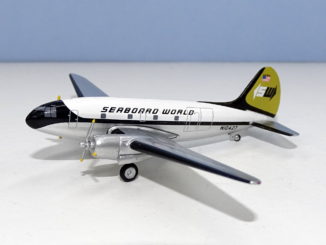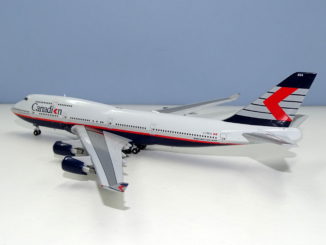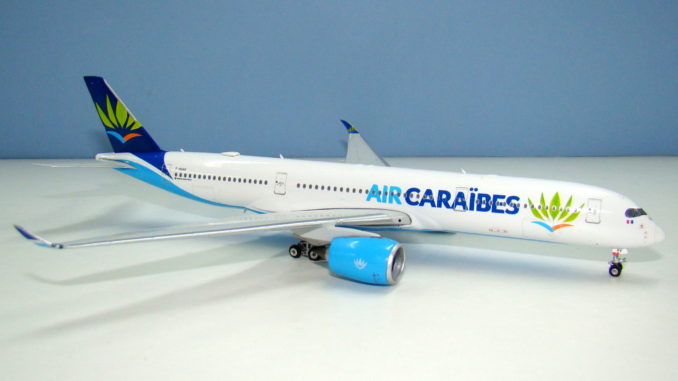
My very first review at Diecast Flier, back in March 2017, was of an A350, but that was the JC Wings mould and until now I’ve not got my hands on the Phoenix version from which I can do a comparison. I love the look of the big Airbus and the livery of Air Caraïbes is possibly the nicest it has worn yet.
THE REAL THING
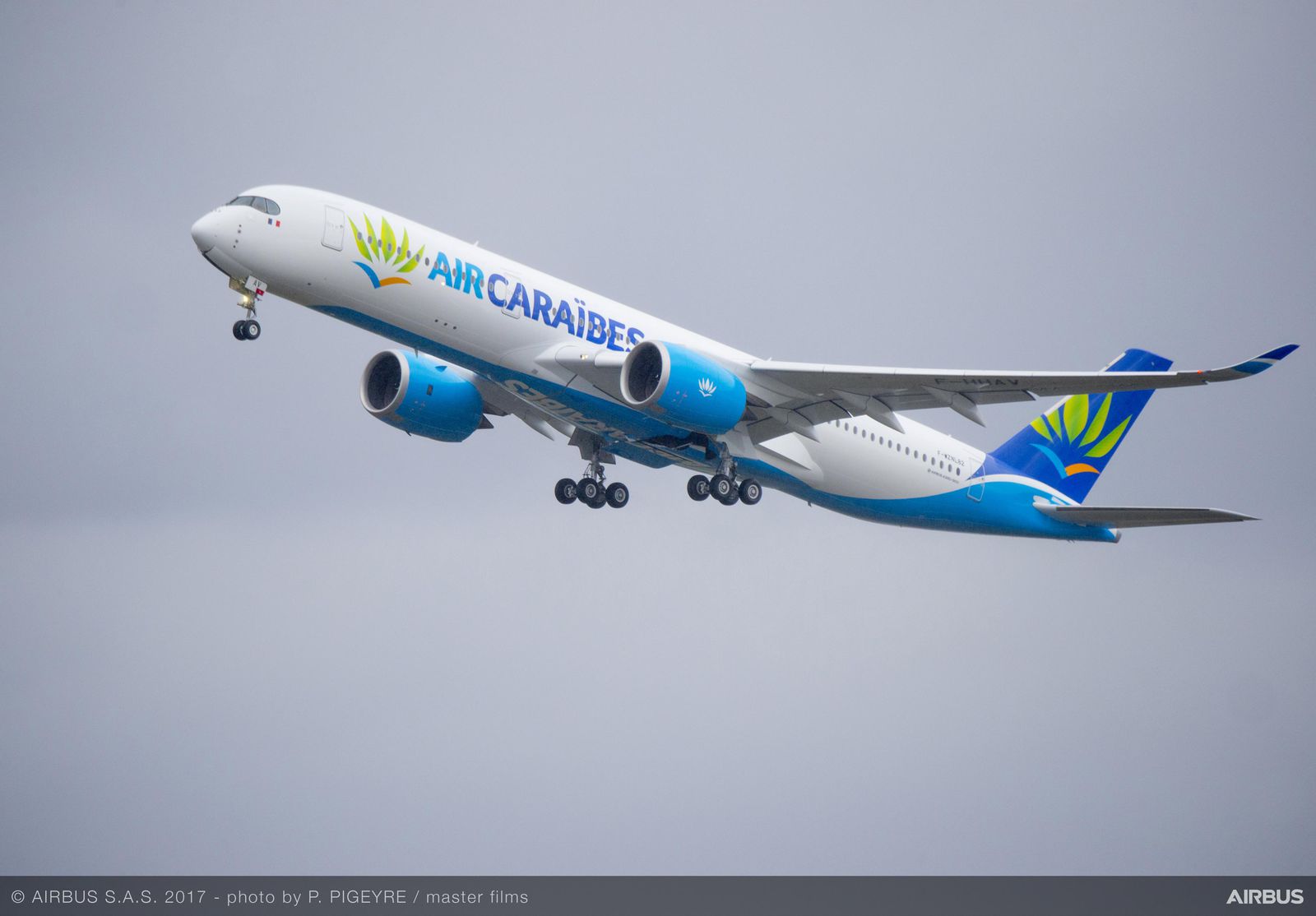
Air Caraïbes is the airline for the French Caribbean made up mainly of the two overseas departments of Guadeloupe and Martinique. It’s history under the current name dates back only until 2000 however it was formed from the combination of a selection of regional airlines comprising Air Guadeloupe, Air Martinique, Air Saint Barthélémy and Air Saint Martin.
The consolidation of these small regional airlines allowed an expansion to enable long haul flights connecting the French Caribbean with the French mainland, which began in 2003 using Airbus A330s to Paris Orly.
Air Caraïbes chose its new generation widebody in December 2013 when it ordered 3 A350-1000s from Airbus and finalised 3 A350-900s on lease from AerCap. The President of the Supervisory Board of the airline not surprisingly said:
“We already benefit from the excellent performance and economics of our fleet of five A330s, and this new order for A350s will allow us to add capacity and give us an unrivalled economic advantage in a very competitive market”.
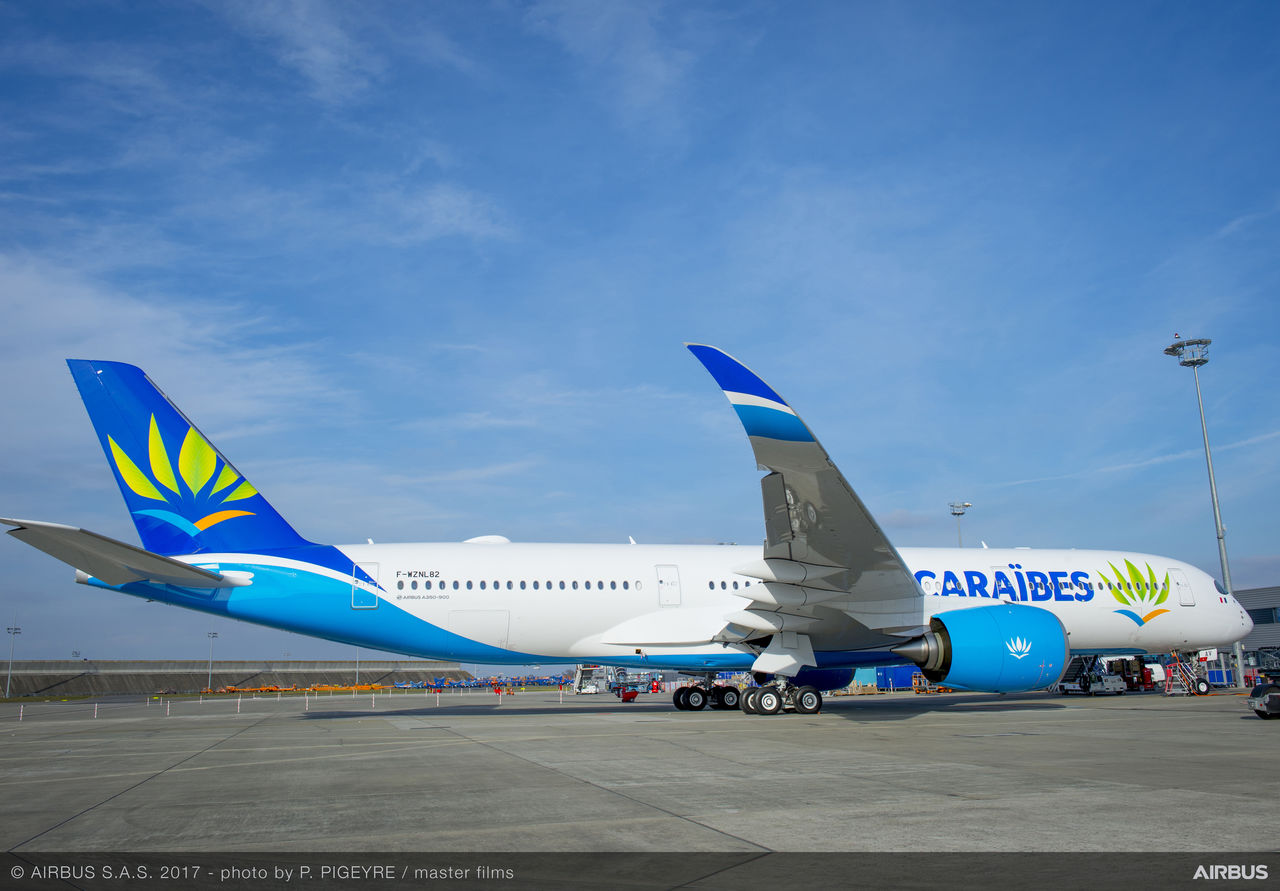
The delivery of the first A350-900 occurred at a ceremony held at the Airbus Delivery Centre in Toulouse on February 28, 2017. The type’s service entry was on March 2, operating from Paris Orly to Pointe-à-Pitre and Fort-de-France. The A350s are configured in a ‘snug’ three class layout for 389 passengers, with 326 in economy, 45 in premium economy and 18 in business class. It is the first operator of the A350 to fit 10 abreast seating in economy with a seat pitch of just 16.8 inches compared to the standard 18 inches.
The service entry makes Air Caraïbes the eleventh operator of the A350 and the first in France. The type offers an upgrade on its A330s but obviously Air Caraïbes is aiming at keeping costs low and using the A350s as a mass mover on its Paris-Caribbean flights rather than a luxury liner. Nonetheless the aircraft certainly look sharp from the outside.
THE MODEL
The format for my reviews is to split them into three key areas:
- The mould of the aircraft
- The paint and livery
- Printing and quality control
Each can get a maximum score of 10 for a section giving a maximum combined total score of 30.
THE MOULD
The Phoenix and JC Wings A350-900 moulds are clearly quite different to each other on the 1/400 scale, however as seems common neither has the perfect combination of features. Starting at the nose and the Phoenix is the winner between the two. The A350 has a slight change of angle at the lower edge of the cockpit, which is pretty much absent from the JC mould but more visible in the Phoenix; having said that the change of angle on the Phoenix happens a little way beneath the cockpit. It’s actually surprising that this difference is so inconsequential to me as the nose is usually the most important part of the mould. Nonetheless on balance I think the Phoenix is best here.
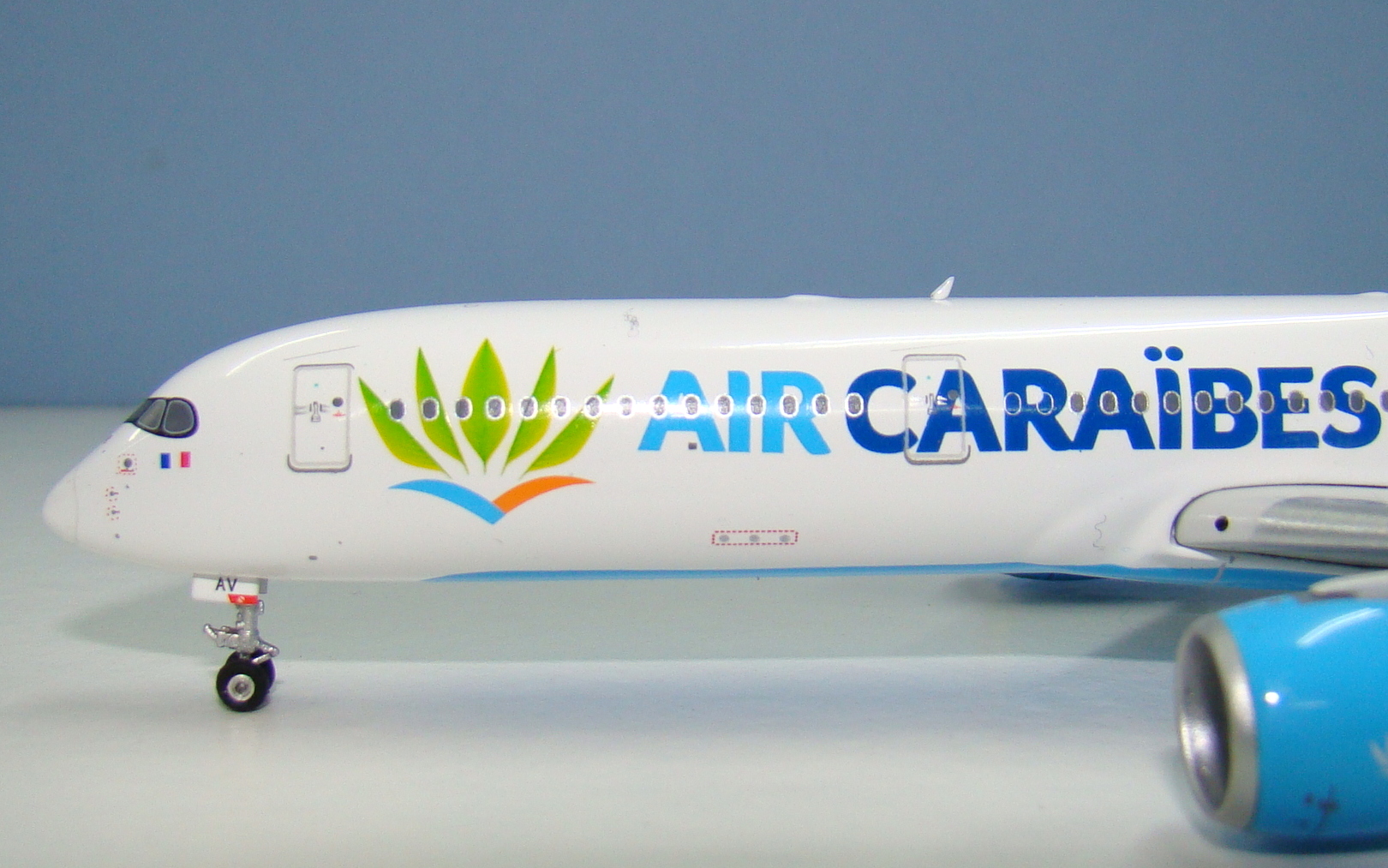
The rest of the fuselage is excellent, with the Phoenix mould having the two small domes above the wing in relief and a nice post wing area. Phoenix also has all aerials present and correct, unlike the JC Wings A350, which lacks the underside aerial.
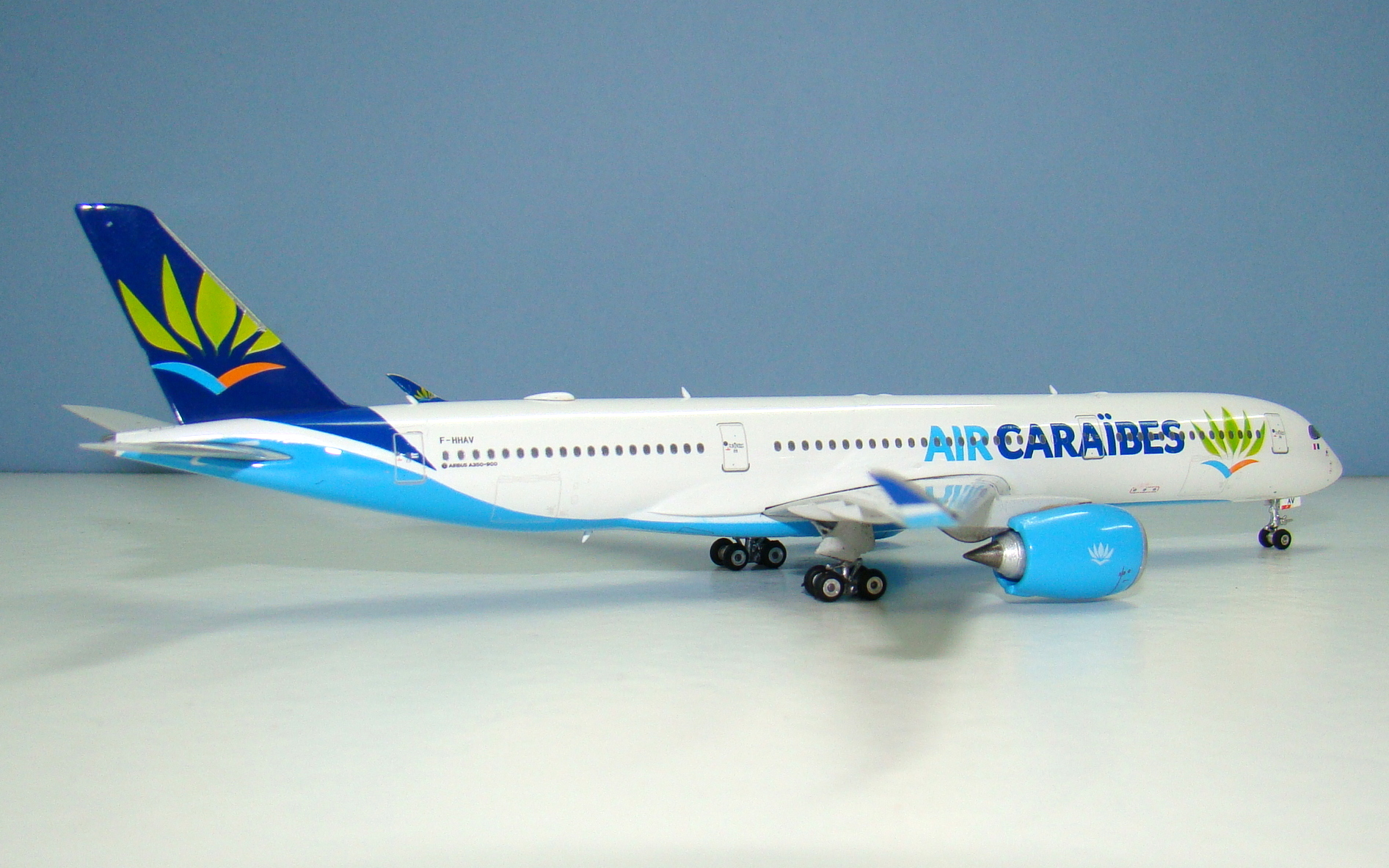
It’s a shame therefore that Phoenix make such a mess of other important areas as their mould is better than the JC Wings so far. The Phoenix mould has a distinctly higher nosegear, which after much staring at photos, I think is also more accurate than the JC Wings however even with this the engine ground clearance is puny.
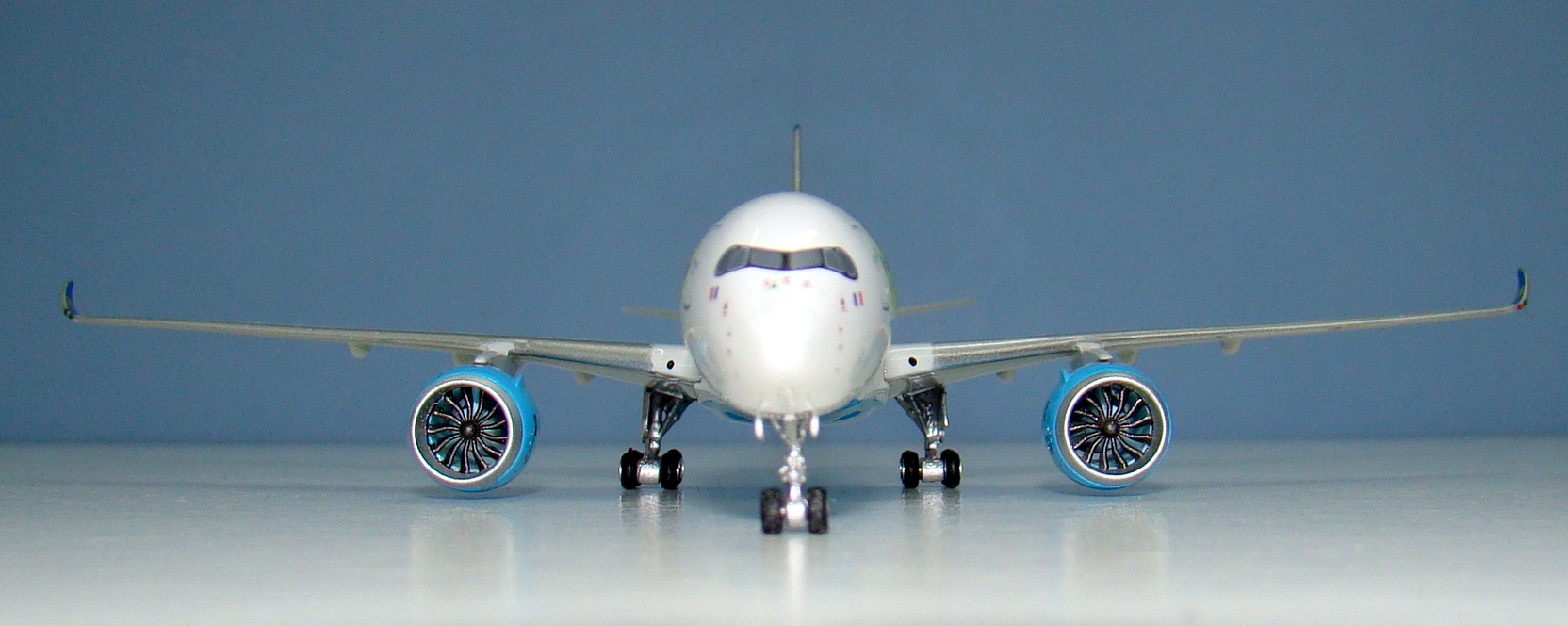
Some earlier Phoenix A350s had engines that actually touched the ground. That isn’t the case here but even so the engines are way too low. This is the fault of the engine pylons, which are the wrong shape. Under the wing they bear little resemblance to the real thing and forward of the wing they attach too low under the wing leading edge. Put the JC Wings engines and pylons on the Phoenix A350 and you have a killer mould. In hindsight I think I over-rated the JC Wings mould in my first review – it’s probably a 8. With the engine pylon issue that the Phoenix mould both moulds have roughly equal failings and so this also gets an 8. Fix the pylons and this is closer to a 10.
SCORE – 8
PAINT & LIVERY
Air Caraïbes has an awesome livery – it’s fresh, colourful and makes you think of a holiday in the sun, which fits well with the airline’s role. I’m not sure exactly what plant the palm-like leaves are meant to be, but hell you don’t come here for botany so I imagine you can forgive me on that! What I do see, from the excellent range of photos on Boeing’s delivery website, is that the livery is more complicated than first meets the eye. This should immediately ring alarm bells with how Phoenix might have done with it!
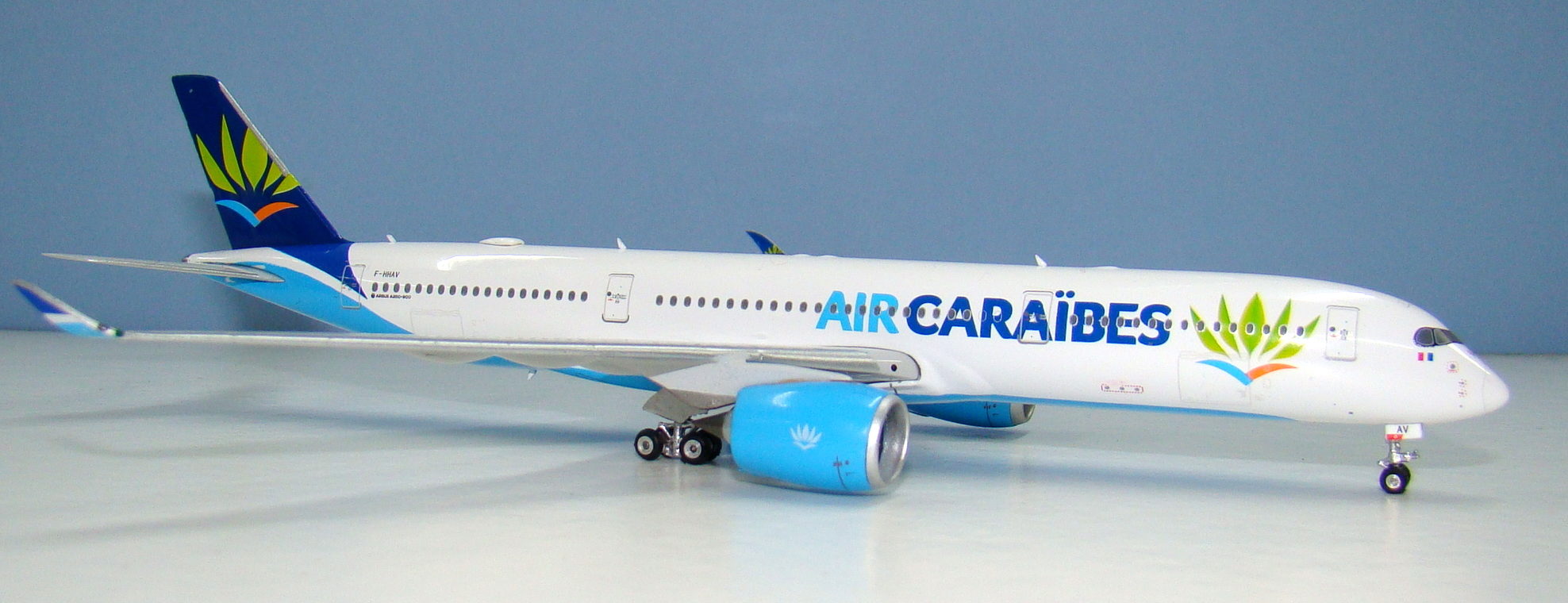
Starting with the colours and the livery has two main blues – a light skyblue and a darker, but still just medium, blue. Phoenix achieve success with the light blue but the darker blue is way off. It is far too dark on the model, more like a navy blue than the rich medium blue. This is a big problem as it’s widely used on the tail, winglets and titles. You know that when I notice the colour is wrong it must be very wrong!
I’ve no complaints with the placement of the livery motifs until you get to the winglets. Otherwise everything is good, but the winglets are plain wrong on both the inside and outside. The Boeing site has close-ups of both, but research is not the strong suit of the manufacturers it seems. On the outside the swish should sweep downwards but on the model it is level. On the inside we wander into an alternative reality. The real thing shows just half the palm leaves – the right half. The Phoenix model tries to show the whole palm and mainly the left half.
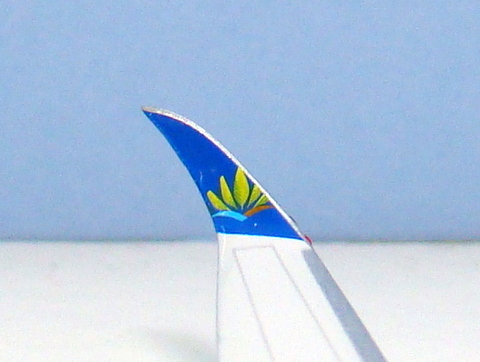
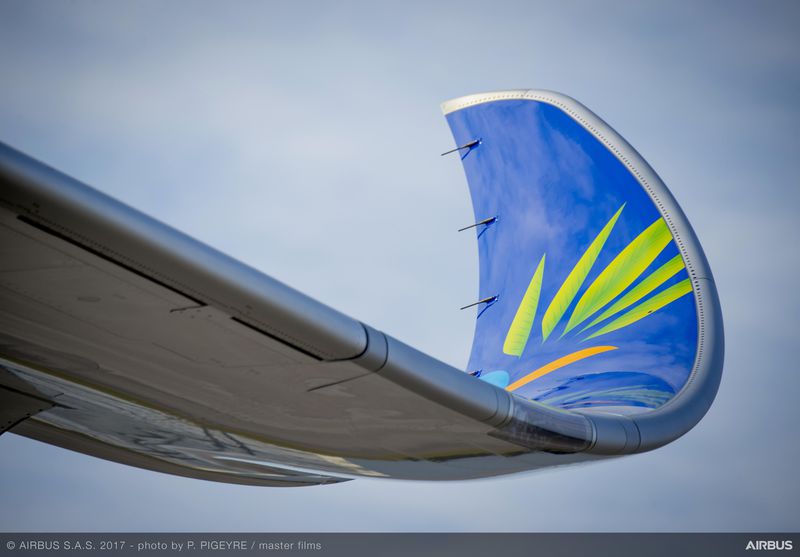
This is not all that is wrong. The real livery actually has clearly painted veins on the leaves giving them relief and detail. Phoenix have not accomplished this well. The leaves near the titles hint at some depth, albeit unconvincingly, but the fronds on the tail are almost vanilla green to the naked eye. Under macro photography some feint veins are visible but there are nowhere near obvious enough especially on the central leaf. In my opinion this is a major flaw akin to misspelling the titles or something.
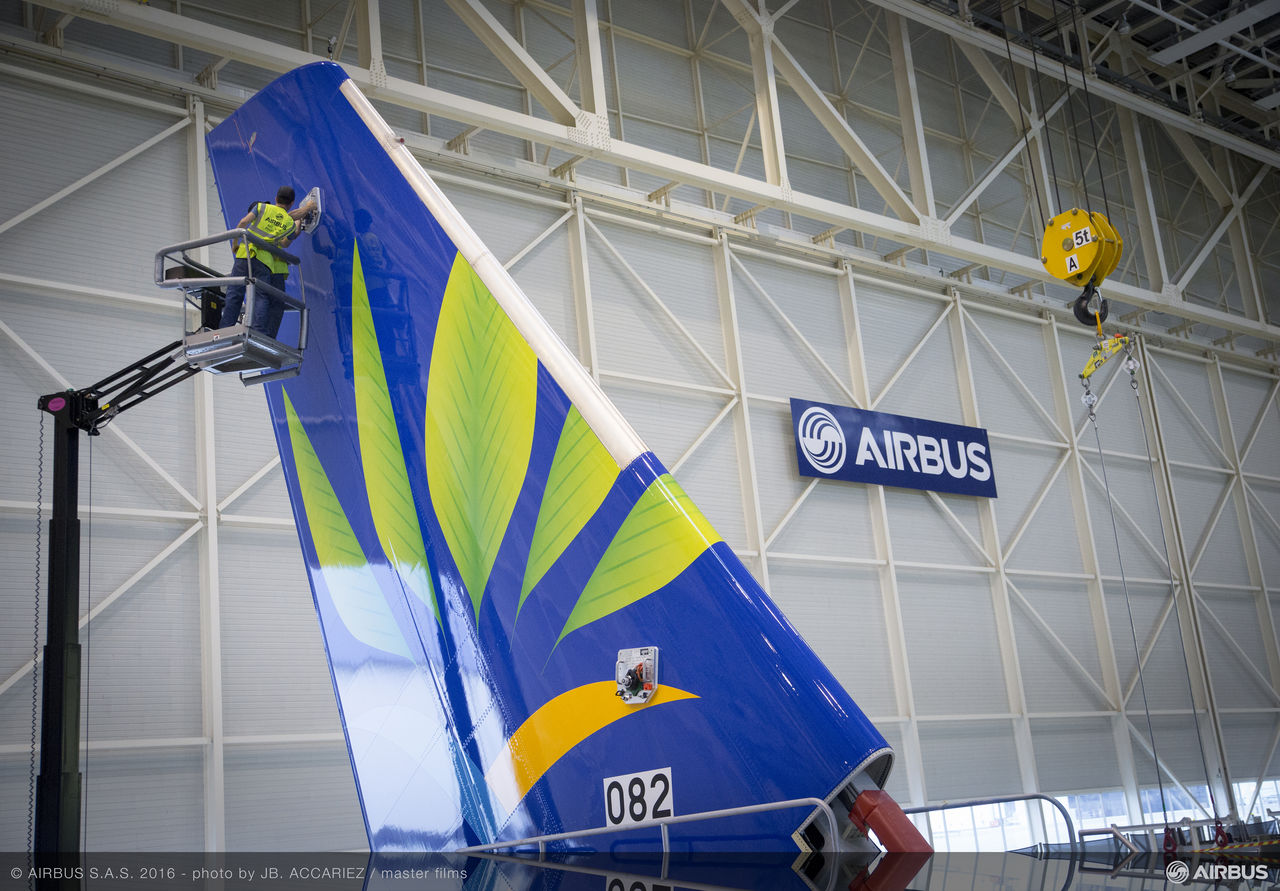

This model is a classic case of something that looks good when it comes out of the box but upon seeing the real thing becomes a major disappointment.
SCORE – 6
PRINTING & QUALITY CONTROL
I have seen a few people who have received this model with its wings detached. This is Phoenix so there shouldn’t really be much surprise there. Thankfully mine comes attached at least. In fairness the printing quality on this model is good. There are no defects and the detail of pitot tubes, doors etc is fine. Having said that I don’t think it is quite up to JC Wings’ standards.
Construction is ok too, the wings and stabilizers are attached well. The undercarriage is not so good. The nosegear out of the box was bent to the left and pushed forward a bit. I was able to gently bend it back into position. The maingear is not correctable. The maingear doors are crude and look like they’ve been hammered into a rough shape. I’ve seen other people get this kind of low quality gear door from Phoenix but it’s the first time I’ve got it.
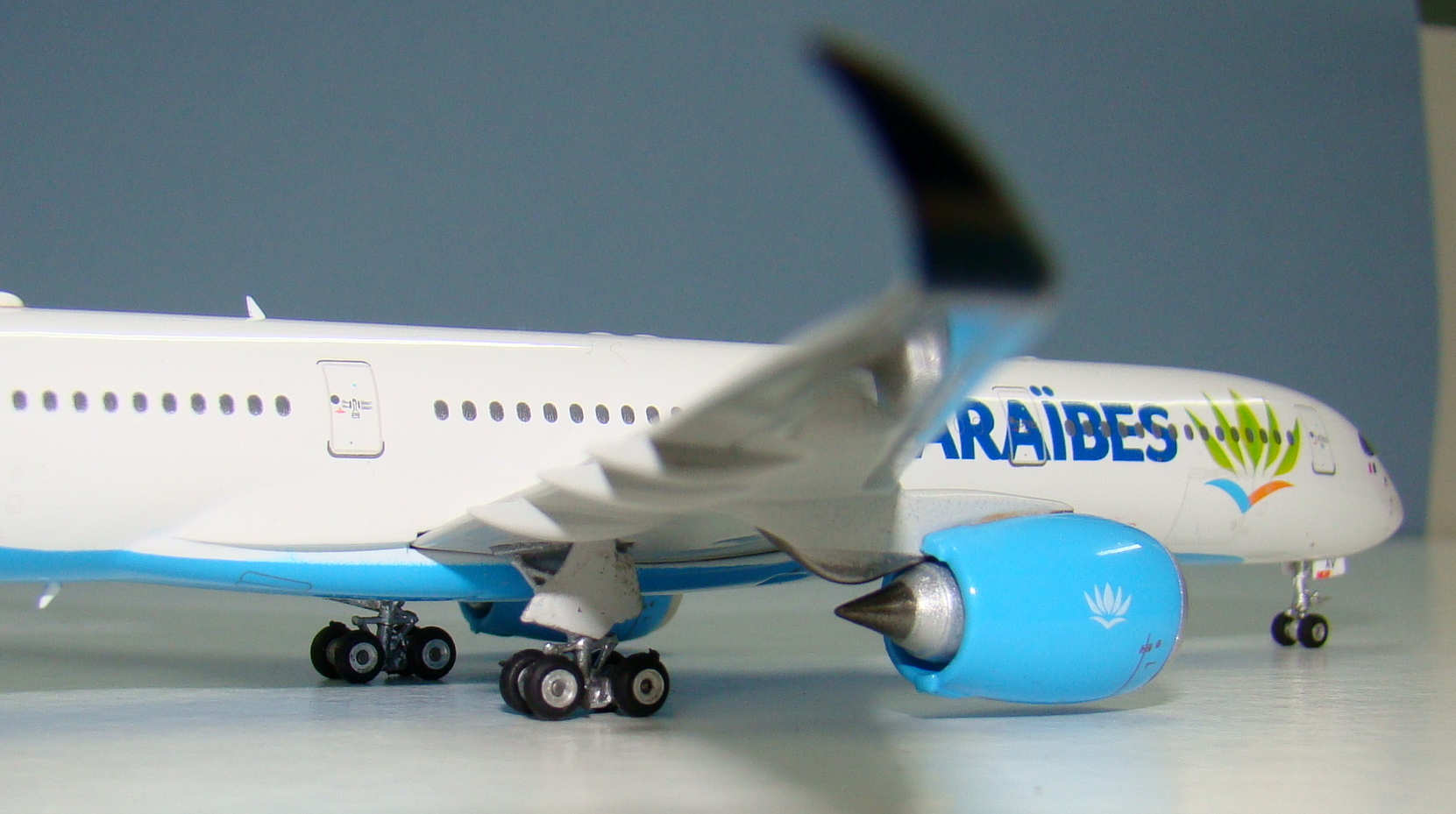
Lastly there is a notch missing on the rudder rear margin about halfway up the vertical stabliser. Not sure what has happened here but maybe the piece was dropped or nicked with something. I am not impressed by the quality of the parts.
SCORE – 7
CONCLUSION
This model should be excellent, but it is not. In every category there are avoidable errors that are not insubstantial. From distance the model works, unless you happen to have a photo of the real thing next to it when the dark blue colour stands out a mile. Take a closer look and problems crop up all over the place with quality just not up to a decent standard. The engine pylons need fixing and the components being used are just not good enough.
FINAL SCORE – 21/30



